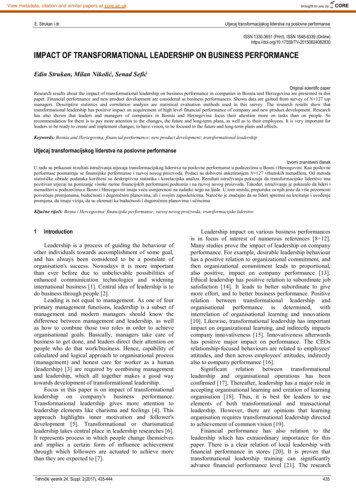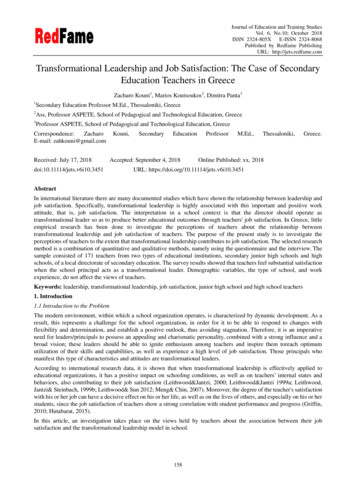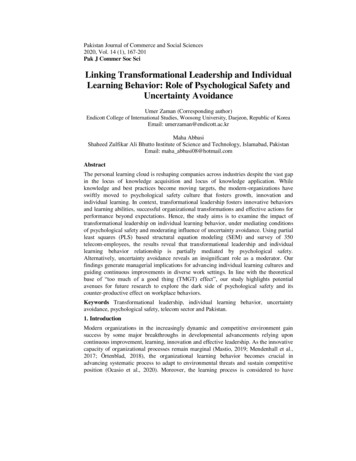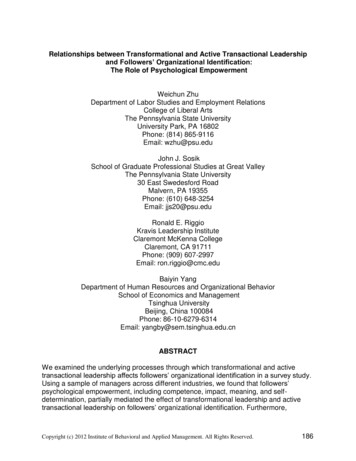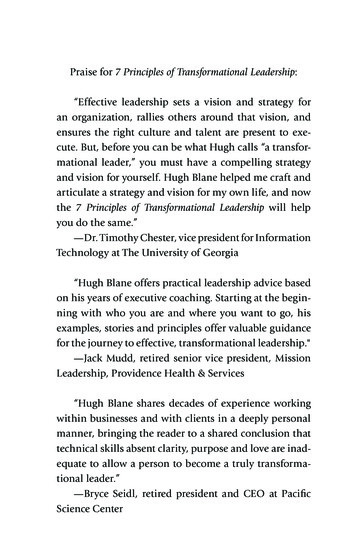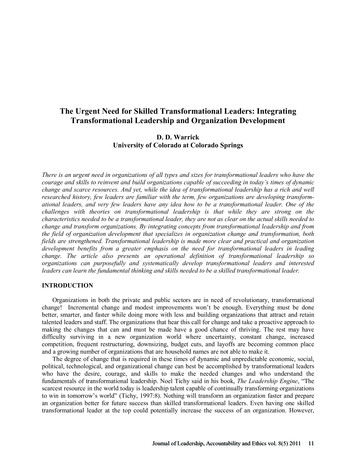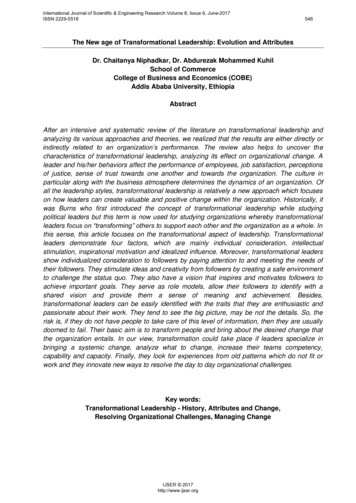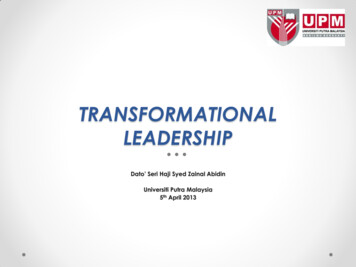
Transcription
TRANSFORMATIONALLEADERSHIPDato’ Seri Haji Syed Zainal AbidinUniversiti Putra Malaysia5th April 2013
Do you know?How much is thecost of developing acar?How manycomponents are in acar?How many engineersare involved inmaking a car?How long does ittake to develop acar?How many partsarrive in our plant ina minute?How frequent does anew car comes outfrom a productionline?
Why does an organizationneeds to transform?Company is doing badlyChanges in the senior leadership teamTechnological changes and upgradesChanges in business strategyReplacement of outdated working practices andprocessesThe need to cut or trim costs and increase efficiencyChallenges resulting from growth, mergers andacquisitionsDownturns and tougher operating conditionsThe need to implement new organization behaviors andskillsThe need to develop change and improveorganizational culture
ChangebusinessstrategyCreating newproductsBut isthisenough?NOHow totransform gementteam
THE KEY TO TRANSFORMA COMPANY IS. . .The Leader!
Guiding Question:How could transformational leadershipbe implemented within an organisation?
DEFINITION OFTRANSFORMATIONALLEADERSHIPA leadership style focused on effectingrevolutionary change in organisations through acommitment to the organisation’s vision(Sullivan & Decker, 2001)
Why transformationalleadership?In 1978, James MacGregor Burns defined the concept of a"transformational leader." His work has been continued andexpanded upon by other researchers, including industrialpsychologist Dr. Bernard Bass. A transformational leader exhibitscertain traits and behaviors to inspire and motivate a team ororganization to rally around a common vision or goal. Thesebehaviors and traits include charisma, intellectual stimulation,inspirational motivation and individual consideration for eachteam or group member. For many reasons, transformationalleadership is an important factor at both the micro, orindividual level, and macro, or organizational, societal level.
What to do and where tostart?i.ii.iii.iv.v.Characteristics of transformational leadershipCommitments of transformational leadershipCreating a visionImplementing the visionSupporting the change and transformation
CHARACTERISTIC OFTRANFORMATIONAL LEADERSHIP Leaders & followers raise one another to higher levels of motivation andmoralityEmpowering others to achieve a shared vision – transforms bothAppeal to individuals to better themselvesFosters followers inborn desires for higher values, morals, humanitarianidealsMoves individuals beyond transactions & interpersonal exchanges toperform beyond basic expectationsUses power to instill a belief followers can do exceptional thingsCommit people to actionConvert followers into leadersConvert leaders into change agents, innovatorsAre courageousBelieve in peopleAre value drivenAre lifelong learnersCan deal with complexity
DIMENSIONS OFTRANSFORMATIONALLEADERSHIPIdealised tual stimulationIndividualisedconsideration follower admiration & respect risk sharing consideration for follower needs ethical & moral conduct (trust) meaning & challenge to work creative problem solving listening, praising(Bass & Avolio, 1994)
KEY CHARACTERCommitmentFamiliarityPersonal giveness & reconciliationEssence of trust Make decisions on what is right rather than self-interest Commit to something more than self When we know someone/ or something well enough Personal relationships Trust based on how we are treated Take responsibility for actions Honesty Self-awareness Lack of self-confidence Walk the talk Predictability of behaviour Open communication Unwilling to deal with sensitive/difficult issue Share perceptions & listen Actual restoration of the interpersonal bond Spiritual & requires faith What is acceptable when we are at home versus at work(Annison & Wilford, 1998)
What to do and where tostart?i.ii.iii.iv.v.Characteristics of transformational leadershipCommitments of transformational leadershipCreating a visionImplementing the visionSupporting the change and transformation
LEADERSHIPCOMMITMENTS Search for opportunities to change/ growExperimentShared uplifting visionInform & share powerIndividualize projectsInvolve teamCommitHarness individual potentialFacilitate conditions for knowledge based workersCelebrate achievements
What to do and where tostart?i.ii.iii.iv.v.Characteristics of transformational leadershipCommitments of transformational leadershipCreating a visionImplementing the visionSupporting the change and transformation
PRE-REQUISITIES Must make sense to the staff Powerful to excite, motivate & generatecommitment Emphasis what may be Clarify what should be(MacKenzie, 1998)
What to do and where tostart?i.ii.iii.iv.v.Characteristics of transformational leadershipCommitments of transformational leadershipCreating a visionImplementing the visionSupporting the change and transformation
FIRST STAGE Uniqueness of groupTrue priorities for next yearWhy would I commit for next 1-5 years?What achievements will make us proud?SECOND STAGE Internal & external needs analysis Identify factors team must achieve to remain viable& productive & develop Formal tools SWOT analysis
What to do and where tostart?i.ii.iii.iv.v.Characteristics of transformational leadershipCommitments of transformational leadershipCreating a visionImplementing the visionSupporting the change and transformation
SUPPORTING THE CHANGEWhat is theinitiativeabout? This initiative aims to transform the mindset and working behaviour of allemployees across the business chain, in tandem with process andoperational excellence initiatives. Ultimately, aligning the company’sculture, values, people and robust processes, to create a high performingorganisation.Why is itimportant? Process Change Management requires Behavioral Change Management tocomplement it. It is imperative that as an organisation to embrace bothchanges which eventually will result in a more agile, responsive, cohesivehence productive working culture Working attitudeWhat shouldchange? Communication channel Legacy issue We will attain an organisation receptive and resilient to changes for sakeof bettermentHow willsuccess looklike? We will forge a cohesive organisation which will strive and motivated for acommon goal We will possess a high performing work culture practising the best-inclass work processesWhat we needfrom theteam? Clearly understand the company imperatives and the need to change Focus more on the future and less on the past; focus more on findingsolutions and less on lamenting on problems Willingness and an unwavering commitment to change and be a part of anew image that will be the model for Malaysia’s global ambitions
Change ManagementFrameworkStart ChangeA BCCollateandinterpretresults ofsurvey Tabling results toClimate survey360 degree survey MD and seniorLeadership survey management teamDennison surveyEngagement survey Not 100%participationTimelineIssueKey activitiesConductorganizationaleffectiveness andleadership surveyImplement & monitor changeDeploy Change Accuracy of results Results are notreadily accessible12 monthsCreate &communicate acoherentvision,andempowerteam toexecuteEDWave 2andbeyondWave 1 Create a changevision Appointment ofChampion andProgram Manager Appointment ofexternal expert Ensure that quickwins can beachieved to anchorsense ofachievement andcredibility Institutionalize newworking culture Build a monitoringprocess to trackchange Champions areineffective Delay appointmentof external expert Average 70%participation No follow-upactivitiies TBD6 months42 48 monthsHighperformingorganization
To ensure effective change management, execution and monitoring so asto become a high performing organizationSteering CommitteeChairman: GMDMCM members Others upon invitationChange ManagementProgram DirectorRisk ManagementTrackingMCM; N-1Change AgentN-2, N-3Change AgentConsultant TeamsOperation ClusterChange AgentCommercial ClusterChange AgentSupport ClusterChange AgentTOR : Creating, and then cascading, a leadership team culture open to constructive conversation soas to enable leaders to actively formulate, among themselves and with subordinates, a commonpurpose, performance goals and agreed working approach to establish mutual accountability(1) As presented at Senior Leadership Change Management Workshop at Holiday Inn Glenmarie – 8 February 2010Source: EPM team
GLOBAL LEADERSHIP
Global LeadershipStructure for good leadershipCore ValuesChange OrientationPeopleManagementGlobal perspectiveStrategic ThinkingHolistic LeadershipPillarsFoundation
Strategic Thinking In today’s highly competitive and fast-changing world, everyonein an organisation must know how to think strategically. The purpose of strategic thinking is to discover novel, imaginativestrategies which can re-write the rules of the competitive game. To envision potential futures, significantly different from thepresent.Considerthe wholevalue chainFocus onachievingthe desiredvisionAdopt newideasRecognisethe stepsthat link thepresent tothe futurevisionFocus ongeneratingnew ideasand testingthe effect ofthese ideas
Global PerspectiveCross CulturalNegotiationGlobalMarketing negotiation in theglobal businesssetting challenges ofentering andoperatingeffectively inforeign markets issues and ethicsthat are unique tothe internationalarena understanding theunique needs anddesires of themarketProducts adaptation ofproducts to meetlocal requirements the right product forthe right market
People Management For any companies to aspire long-term vision,leadership qualities are imperative amongcurrent and potential leaders across all levels. Leaders must have the ability to connect withcustomers, cooperate with peers and competewith the rest of the players to stay ahead of thegame.
People can be like Icebergs10% - Good But LimitedInformation:Education, Experience, Skills,Your Gut Feel90% - Essence of the TotalPerson: Thinking Style Behavioral Traits Occupational Interests Job FitWe need to feed both aspectsof a person
Elements of Change OrientationHow to respond positively and flexibly to changingenvironments and priorities; adapts well in times of ambiguityand change- Change in strategy- Restructuring activities- New technologies- Major collaborations- new programs such as Total Quality Management, reengineering, etc.- Top down approach- Company-wide initiative- Increased and sustained communications and education- To provide forum for employees to express concerns
Leadership: Can it be HolisticLeading from the mind, the heart and the soulHolistic leaders continuously strive towards creating a culture of openness, trust, respect,participation, empowerment, and growth.Holistic LeaderIntellectualEmotionalTechnical & businessknowledgeSelf-awareness, selfregulation,motivation, empathy,and social skills.SpiritualVirtuous behaviour:Sabr (Patience)Hikmah (Wisdom)Tawakkul (Reliance on Allah)Bai'yah (Allegiance)Ihtisab (Accountability)
Dynamics of Positive idencePatienceHumilityBeliefBehavior Personality incereWarmRelaxedResultsDaily Living Lead toSeven great attitudes ner-Peace
Communication SessionsCommunicating a clear sense of purpose and directionTown Hall Session between MD and PROTON executivesPre-production Launch by MD with workers and vendors
Focuses on Spiritual Aspects ofLeadershipWithin theworkingenvironmentOutside theworkingenvironment Azan (call for payers) inthe production and officearea Regular talks on religiousand spiritual subjectsamong employees Non work related activities Team building activities Sports & recreationalactivitiesTo create and strengthen the spiritual awareness among leaders and employees
Allah will not change the goodcondition of a people as long as theydo not change their state of goodnessthemselves (by committing sins and bybeing ungrateful and disobedient toAllah) (Surah Ar-Rad : Ayat 11)We have to take charge of our destiny (collective and individually)
Why transformational leadership? In 1978, James MacGregor Burns defined the concept of a "transformational leader." His work has been continued and expanded upon by other researchers, including industrial psychologist Dr. Bernard Bass. A transformational leader exhibits certain traits and behaviors to inspire and motivate a team or
